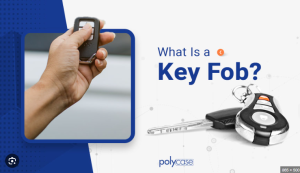
In today’s digital age, securing your data and online accounts is more critical than ever. Cyberattacks, phishing attempts, and identity theft are on the rise, and traditional password-based protection is no longer sufficient. This is where a computer security key fob comes into play—a compact, portable device that offers strong two-factor authentication (2FA) and significantly enhances cybersecurity.
In this comprehensive guide, we’ll dive deep into what a computer security key fob is, how it works, its benefits, top brands, and why it’s becoming an essential tool for both individuals and organizations.
What Is a Computer Security Key Fob?
A computer security key fob, often called a security token or hardware authentication device, is a small physical device used to authenticate a user’s identity. Typically, it connects to a computer via USB, Bluetooth, or NFC (Near Field Communication) and provides an extra layer of security beyond just a username and password.
Security key fobs are most commonly used for:
- Two-Factor Authentication (2FA)
- Multi-Factor Authentication (MFA)
- Passwordless logins
- Access to sensitive networks or systems
Unlike software-based authenticators, a key fob can’t be hacked remotely. This makes it one of the most secure authentication methods available today.
How Does a Security Key Fob Work?
The functionality of a security key fob relies on cryptographic principles. Here’s how it typically works:
- Registration: The user registers the key with a compatible service or platform (Google, Microsoft, Facebook, GitHub, etc.).
- Authentication: When logging in, the user inserts the key into a USB port or taps it on a device using NFC/Bluetooth.
- Verification: The key sends a cryptographic signature that verifies the user’s identity.
- Access Granted: If the credentials match, access is granted—no password required, or it acts as a second factor if a password is also used.
Many fobs are compliant with standards like FIDO2 and U2F (Universal 2nd Factor), ensuring compatibility with hundreds of platforms and services.
Benefits of Using a Computer Security Key Fob
1. Enhanced Security
Security fobs reduce the risk of phishing, man-in-the-middle attacks, and keyloggers. Even if a hacker gets your password, they cannot log in without your physical key.
2. User-Friendly
Unlike complex password managers or software-based 2FA that require app installations, key fobs are plug-and-play and require minimal setup.
3. Portability
Small enough to fit on a keychain, a security key fob can go wherever you go—ensuring you have access without compromising security.
4. Passwordless Access
Many key fobs support passwordless authentication, aligning with modern identity and access management trends. This simplifies the login process while boosting security.
5. Compliance with Security Regulations
Businesses can use key fobs to comply with cybersecurity standards like GDPR, HIPAA, and CCPA, ensuring strong authentication protocols.
Who Should Use a Security Key Fob?
While anyone concerned with cybersecurity can benefit, key fobs are especially valuable for:
- IT professionals and developers
- Journalists and activists
- Remote workers and digital nomads
- Healthcare professionals
- Finance and banking employees
- Business owners and executives
In short, if your work or personal life involves sensitive information, a security key fob is a must-have.
Popular Security Key Fob Brands
Here are some of the top-rated brands offering computer security key fobs:
1. YubiKey by Yubico
YubiKey is arguably the most well-known brand. Models like the YubiKey 5 Series support USB-A, USB-C, NFC, and work with Windows, macOS, Android, iOS, and Linux.
2. Google Titan Security Key
Google’s Titan key offers both USB and Bluetooth options and is optimized for use with Google accounts and services.
3. Feitian
Feitian keys are affordable, FIDO-compliant, and work well across different operating systems and cloud platforms.
4. Thetis
Thetis offers competitively priced USB and USB-C key fobs with support for major authentication protocols.
How to Set Up a Security Key Fob
Setting up a security key fob is straightforward:
- Buy a compatible key (make sure it supports the platforms you use).
- Go to the security settings of your account (e.g., Google Account > Security > 2-Step Verification).
- Add a Security Key and follow the on-screen instructions.
- Test it out by logging out and logging back in.
Some services allow multiple key registrations, so you can have a backup in case you lose your primary fob.
Security Key Fob vs. Other 2FA Methods
| Feature | SMS-Based 2FA | Authenticator App | Security Key Fob |
|---|---|---|---|
| Security Level | Low | Medium | Very High |
| Risk of Phishing | High | Medium | Very Low |
| Ease of Use | Moderate | Moderate | High |
| Offline Functionality | No | Yes | Yes |
| Setup Time | Fast | Moderate | Fast |
As the table shows, key fobs provide the highest level of security and are ideal for those looking to eliminate vulnerabilities in their authentication process.
Tips for Using a Security Key Fob Safely
- Keep a backup key in case you lose your primary one.
- Use a strong master password if your account supports it alongside the key.
- Label your keys if you use them for different platforms.
- Avoid cheap, non-certified brands that might compromise security.
- Update firmware if supported by your manufacturer.
The Future of Authentication
Security key fobs are part of a larger trend toward passwordless authentication. With tech giants like Google, Microsoft, and Apple investing heavily in FIDO2 standards, we can expect a broader shift away from traditional passwords toward hardware-based and biometric solutions.
Key fobs will likely become as common as passwords once were—essential tools in every user’s digital toolkit.
Conclusion
A computer security key fob is one of the most powerful and user-friendly tools for protecting your digital life. Whether you’re a tech-savvy developer or a casual user, these devices provide unmatched protection against today’s most sophisticated cyber threats.